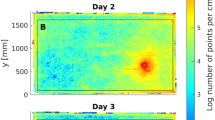Abstract
Although visual cues are essential for navigation in ants, few studies address movement dynamics in ants when they search and forage after finding food in an unfamiliar environment. Here I introduced Japanese wood ants to an unfamiliar food location by capturing individuals leaving their nest. The food was located at the centre of a straight, narrow, open-top channel. Next, I determined the segment lengths of the foraging paths of the ants between consecutive U-turns. I found that individuals travelled along characteristic and complex paths if they detected a visual landmark. This movement property was not detectable when individuals foraged in the channel without any visual landmarks. These results reveal the movement dynamics of ants when they encounter food in a novel place.






Similar content being viewed by others
References
Bartumeus F, Luz MGE, Viswanathan GM, Catalan J (2005) Animal search strategies: a quantitative random-walk analysis. Ecology 86(11):3078–3087
Börger L, Dalziel BD, Fryxell JF (2008) Are there general mechanisms of animal home range behaviour? A review and prospects for future research. Ecol Lett 11:637–650
Bregy P, Sommer S, Wehner R (2008) Nest-mark orientation versus vector navigation in desert ants. J Exp Biol 211:1868–1873
Collett TS, David DL, Graham P (2014) Scene perception and the visual control of travel direction in navigating wood ants. Phil Trans R Soc B 369:20130035 (1–10)
Czaczkes TJ, Weichselgartner T, Bernadou A, Heinze J (2016) The effect of trail pheromone and path confinement on learning of complex routes in the ant Lasius niger. PloS One 11(3):e0149720
Durier V, Graham P, Collett TS (2003) Snapshot memories and landmark guidance in wood ants. Curr Biol 13(18):1614–1618
Fleischmann PN, Christian M, Müller VL, Rössler W, Wehner R (2016) Ontogeny of learning walks and the acquisition of landmark information in desert ants, Cataglyphis fortis. J Exp Biol 219:3137–3145
Fourcassie V, Coughlin D, Trainello FFA (1992) Fractal analysis of search behavior in ants. Naturwissenschaften 79:87–89
Fourcassié V, Traniello JFA (1994) Food searching behaviour in the ant Formica schaufussi (Hymenoptera, Formicidae): response of naive foragers to protein and carbohydrate food. Anim Behav 48:69–79
Fukushi T (2001) Homing in wood ants, Formica japonica: use of the skyline panorama. J Exp Biol 204:2063–2072
Fukushi T, Wehner R (2004) Navigation in wood ants, Formica japonica: context dependent use of landmarks. J Exp Biol 207:3431–3439
Harris RA, Graham P, Collett TS (2007) Visual cues for the retrieval of landmark memories by navigating wood ants. Curr Biol 17(2):93–102
Li L, Peng H, Kurths J, Yang Y, Schellnhuber HJ (2014) Chaos-order transition in foraging behavior of ants. Proc Natl Acad Sci USA 11(23):8392–8397
Mailleux AC, Deneubourg JL, Detrain C (2000) How do ants assess food volume? Anim Behav 59:1061–1069
Merkle T, Wehner R (2010) Desert ants use foraging distance to adapt the nest search to the uncertainty of the path integrator. Behav Ecol 21(2):349–355
Müller M, Wehner R (2010) Path integration provides a scaffold for landmark learning in desert ants. Curr Biol 20:1368–1371
Nicholson DJ, Judd SP, Cartwright BA, Collett TS (1999) Learning walks and landmark guidance in wood ants (Formica rufa). J Exp Biol 202(Pt 13):1831–1838
Peng CK, Mietus J, Hausdorff JM, Havlin S, Stanley HE, Goldberger AL (1993) Long-range anticorrelations and non-Gaussian behavior of the heartbeat. Phys Rev Lett 70:1343–1346
Petrovskii S, Mashanova A, Jansen VAA (2011) Variation in individual walking behavior creates the impression of a Levy flight. Proc Natl Acad Sci USA 108:8704–8707
Pittman-Polletta B, Scheer FA, Butler M, Shea SA, Hu K (2013) The role of the circadian system in fractal neurophysiological control. Biol Rev 88(4):873–894
Reynolds AM, Smith AD, Reynolds DR, Carreck NL, Osborbe JL (2007) Honeybees perform optimal scale-free searching flights when attempting to locate a food source. J Exp Biol 210:3763–3770
Reynolds AM, Schultheiss P, Cheng K (2014) Does the Australian desert ant Melophorus bagoti approximate a Lévy search by an intrinsic bi-modal walk? J Theor Biol 340:17–22
Schultheiss P, Cheng K (2013) Finding food: outbound searching behavior in the Australian desert ant Melophoru sbagoti. Behav Ecol 24:128–135
Schultheiss P, Wystrach A, Legge ELG, Cheng K (2013) Information content of visual scenes influences systematic search of desert ants. J Exp Biol 216:742–749
Sommer S, Wehner R (2004) The ant’s estimation of distance travelled: experiments with desert ants, Cataglyphis fortis. J Comp Physiol A 190:1–6
Théraulaz G, Bonabeau E, Sauwens C, Deneubourg JL, Lioni A, Libert F, Passera L, Solé R (2001) Model of droplet dynamics in the argentine ant Linepthema Humile (Mayr). Bull Math Biol 63:1079–1093
Viswanathan GM, Raposo EP, da Luz MGE (2008) Levy flights and superdiffusion in the context of biological encounters and random searches. Phys Life Rev 5(3):133–150
Wehner R, Müller M (2010) Piloting in desert ants: pinpointing the goal by discrete landmarks. J Exp Biol 213:4174–4179
Wehner R, Srinivasan MV (1981) Searching behaviour of desert ants, genus Cataglyphis (Formicidae, Hymenoptera). J Comp Physiol 142:315–338
Wehner R, Michel B, Antonsen PJ (1996) Visual navigation in insects: coupling of egocentric and geocentric information. Exp Biol 199:129–140
Wehner R, Boyer M, Loertscher F, Sommer S, Menzi U (2006) Ant navigation: one-way routes rather than maps. Curr Biol 16(1):75–79
Yamamoto A, Ishihara S, Ito F (2009) Fragmentation or transportation: mode of large-prey retrieval in arboreal and ground nesting ants. J Insect Behav 22:1–11
Zeil J (2012) Visual homing—an insect perspective. Curr Opin Neurobiol 22:285–293
Acknowledgements
This work was supported by Japan Society for the Promotion of Science (JSPS) KAKENHI Grant number 18K18343.
Author information
Authors and Affiliations
Corresponding author
Electronic supplementary material
Below is the link to the electronic supplementary material.
Rights and permissions
About this article
Cite this article
Sakiyama, T. Emergence of a complex movement pattern in an unfamiliar food place by foraging ants. J Comp Physiol A 205, 61–66 (2019). https://doi.org/10.1007/s00359-018-1303-z
Received:
Revised:
Accepted:
Published:
Issue Date:
DOI: https://doi.org/10.1007/s00359-018-1303-z




